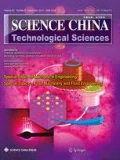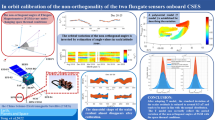Abstract
High precision magnetometer (HPM) is a magnetic field detection payload onboard China Seismo-Electromagnetic Satellite (CSES), including two fluxgate magnetometers (FGM) and a coupled dark state magnetometer (CDSM). Observations show that FGM appears to be influenced when tri-band beacon (TBB) is powered on and emits electromagnetic waves. The interference phenomenon is further validated based on both in-orbit observation analysis and electromagnetic compatibility (EMC) tests on the ground. A joint correction algorithm based on the least square fitting and first-order difference method according to scalar magnetometer data is proposed to eliminate the interference. The algorithm significantly improves the consistency of HPM data. After correction, the average scalar deviation error could be reduced from 9.0 nT to around 0.7 nT.
Similar content being viewed by others
References
Shen X H, Zhang X M, Yuan S G, et al. The state-of-the-art of the China Seismo-Electromagnetic Satellite mission. Sci China Tech Sci, 2018, 61: 634–642
Wang L, Hu Z, Shen X H, et al. Data processing methods and procedures of CSES satellite (in Chinese). J Remote Sens, 2018, 22: 39–55
Cheng B J, Zhou B, Magnes W, et al. High precision magnetometer for geomagnetic exploration onboard of the China Seismo-Electromagnetic Satellite. Sci China Tech Sci, 2018, 61: 659–668
Pollinger A, Lammegger R, Magnes W, et al. Coupled dark state magnetometer for the China Seismo-Electromagnetic Satellite. Meas Sci Technol, 2018, 29: 095103
Pollinger A, Amtmann C, Betzler A, et al. In-orbit results of the coupled dark state magnetometer aboard the China Seismo-Electromagnetic Satellite. Geosci Instrum Method Data Syst, 2020, 9: 275–291
Zhou B, Cheng B, Gou X, et al. First in-orbit results of the vector magnetic field measurement of the high precision magnetometer onboard the China Seismo-Electromagnetic Satellite. Earth Planets Space, 2019, 71: 119
Gou X, Li L, Zhang Y, et al. Ionospheric Pc1 waves during a storm recovery phase observed by the China Seismo-Electromagnetic Satellite. Ann Geophys, 2020, 38: 775–787
Yang Y Y, Zhima Z R, Shen X H, et al. The first intense geomagnetic storm event recorded by the China Seismo-Electromagnetic Satellite. Space Weather, 2020, 18: e02243
Yang Y, Hulot G, Vigneron P, et al. The CSES global geomagnetic field model (CGGM): An IGRF-type global geomagnetic field model based on data from the China Seismo-Electromagnetic Satellite. Earth Planets Space, 2021, 73: 45
Alken P, Thébault E, Beggan C D, et al. International geomagnetic reference field: The thirteenth generation. Earth Planets Space, 2021, 73: 49
Olsen N, Lühr H, Sabaka T J, et al. CHAOS—a model of the Earth’s magnetic field derived from CHAMP, Ørsted, and SAC-C magnetic satellite data. Geophys J Int, 2006, 166: 67–75
Zhou B, Yang Y Y, Zhang Y T, et al. Magnetic field data processing methods of the China Seismo-Electromagnetic Satellite. Earth Planets Phys, 2018, 2: 455–461
Ruder S. An overview of gradient descent optimization algorithms. arXiv: 1609.04747
Nesterov Y E. A method for solving the convex programming problem with convergence rate o(1/k2). Soviet Math Dokl, 1983, 27: 372–376
Sutskever I, Martens J, Dahl G, et al. On the importance of initialization and momentum in deep learning. In: The Proceedings of the 30th International Conference on Machine Learning. Atlanta: ICML, 2013. 1139–1147
Polyak B T. Some methods of speeding up the convergence of iteration methods. USSR Comput Math Math Phys, 1964, 4: 1–17
Tukey J. Nonlinear (nonsuperposal) methods for smoothing data. In: The Proceedings of the Congress Record EASCON. Washington, 1974
Author information
Authors and Affiliations
Corresponding author
Additional information
This work was supported by the National Key Research and Development Program of China (Grant Nos. 2018YFC1503501, 2016YBF0501503), the Dragon 5 Cooperation 2020–2024 (Grant No. 59236), and the International Space Science Institute-Beijing (Grant No. 2019IT-33). This research made use of the data from CSES mission, a project funded by China National Space Administration (CNSA) and China Earthquake Administration (CEA).
Rights and permissions
About this article
Cite this article
Tong, Y., Cheng, B., Miao, Y. et al. Analysis and elimination of tri-band beacon interference with the fluxgate sensors onboard CSES. Sci. China Technol. Sci. 64, 2328–2336 (2021). https://doi.org/10.1007/s11431-020-1799-y
Received:
Accepted:
Published:
Issue Date:
DOI: https://doi.org/10.1007/s11431-020-1799-y



